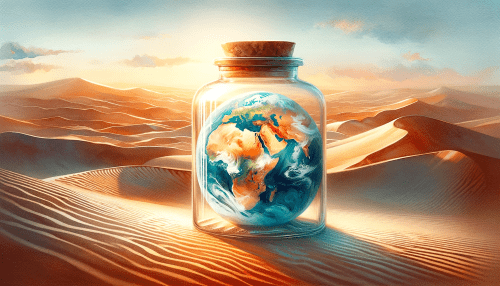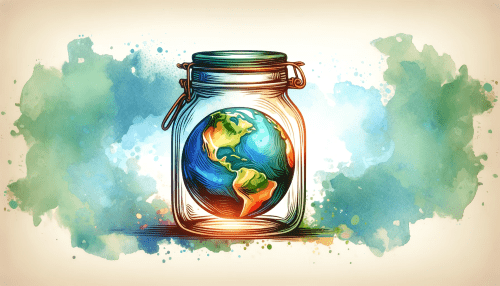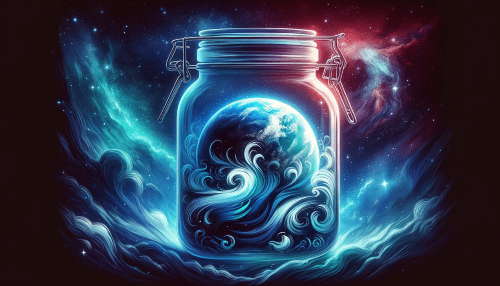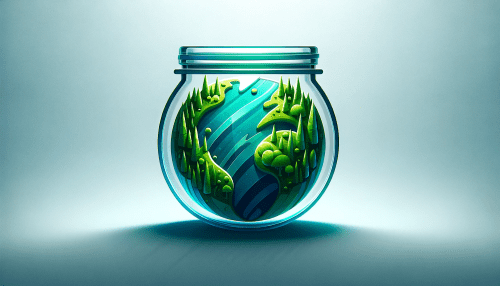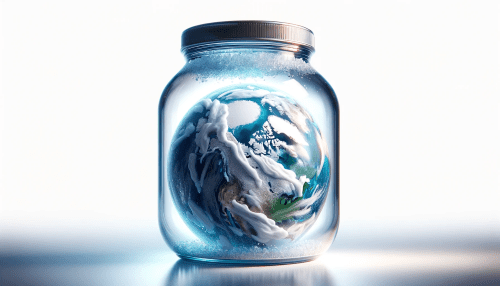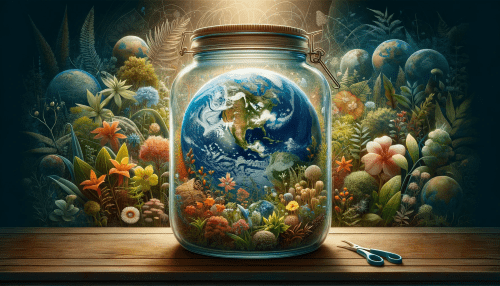Introduction:
In the arresting “Earth in a Jar” series, a poignant narrative unfolds—one of beauty, isolation, and change. The fourth theme, showcasing deserts encased in glass, is more than a visual feast; it’s a metaphor for the sweeping alterations our planet endures under humanity’s watch. This collection, part of the larger “Life in a Jar: An Artistic Examination of Social Isolation” project, brings the stark reality of climate change to the forefront, urging us to consider our role in Earth’s transformation.
The thumbnail crafted for the blog article is a striking visual metaphor on the theme of climate change. At its heart lies a delicately rendered Earth, resplendent in its vibrant blues and greens, encapsulated within the clear confines of a classic glass jar. This image of the Earth is not whole; it is truncated, with sprawling deserts dominating its visible surface. The sandy hues range from soft golden to deep amber, depicting a world where arid landscapes are expanding, encroaching upon what was once verdant.
The jar, meticulously detailed with reflections and subtle highlights, stands against a backdrop that mirrors the deserts within. The terrain outside is a textured expanse of dunes, evoking the undulating patterns of wind-sculpted sand. Sparse vegetation punctuates this desert, their presence a testament to life’s tenacity but also a signal of its scarcity in the face of environmental change.
This composition juxtaposes the lushness of life against the sterility of the desert, confined yet exposed in a transparent vessel. It is both a showcase and a warning—a world preserved as if a specimen yet vulnerable and affected by the world beyond the glass.
The image, set with a 3:2 aspect ratio, is poised to capture the viewer’s attention, drawing them into a narrative of beauty, fragility, and the stark reality of our planet’s future. It beckons the reader to delve deeper into the blog article, promising a discussion as profound and moving as the art itself.
The planet Earth in a jar, showing only deserts to represent climate change, Artwork 1
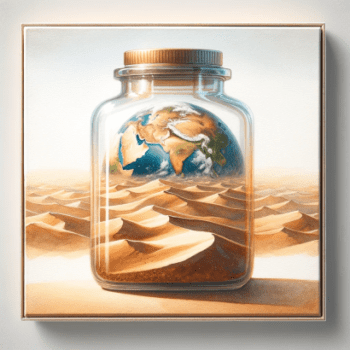
“The Solitude of Deserts: Earth’s Climate in Containment” stands as a poignant testament to the stark beauty and the profound isolation that deserts represent. This first artwork in the theme “The Planet Earth in a Jar, Showing Only Deserts to Represent Climate Change” presents a striking visual narrative of our planet’s changing climate.
The Earth is rendered as a miniature tableau within a glass jar, its landmasses dominated by the expansive deserts that stretch across its surface. The deserts are depicted with a realism that captures the undulating dunes and the shifting sands, each ridge and trough painted in a palette of tans, ochres, and sienna. The intricate play of light and shadow across the dunes conveys the relentless desert sun, evoking a sense of the intense heat and the relentless passage of time that carves these vast, arid landscapes.
The glass jar, with its transparent simplicity, serves both as a lens through which we observe this microcosm of Earth and as a symbol of the planet’s fragility in the face of climate change. The jar suggests our attempt to understand and contain the vast, complex mechanisms behind our planet’s shifting environments, underscoring humanity’s role in both the preservation and alteration of the natural world.
The backdrop against which this jar is set is a textured canvas, its neutrality putting the focus squarely on the jar and its contents. The shadow beneath the jar adds weight and depth to the image, grounding the composition and reinforcing the message of Earth’s weighty presence and the deep footprints we leave upon its surface.
This artwork is a call to reflection, a beautifully rendered piece that invites contemplation of the desolate grandeur of Earth’s deserts and the broader implications of environmental change. It is an artistic reminder of the delicate balance between our planet’s natural wonders and the impact of our actions, inviting viewers to engage with the critical discourse on climate change.
The planet Earth in a jar, showing only deserts to represent climate change, Artwork 2
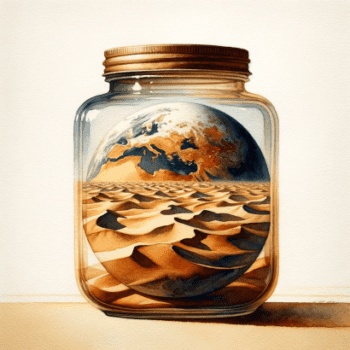
Within the confines of a simple glass jar, the second artwork of the theme “The Planet Earth in a Jar, Showing Only Deserts to Represent Climate Change” poignantly encapsulates the vast and arid beauty of the Earth’s deserts. The watercolor painting creates a captivating visual narrative that reflects on the consequences of climate change and its amplification of desert landscapes.
The Earth, nestled within the glass, is presented with a topography dominated by deserts. The hues of burnt umber, ochre, and sepia intertwine to form the rolling dunes and stark landscapes that characterize these dry expanses. Each grain seems almost tangible, a testament to the meticulous detail the artist has employed to bring this environment to life. The craftsmanship conveys not only the texture of the sand but also the heat that emanates from its surface, mirroring the intense environment where water is a fleeting luxury.
Above the desert, the globe is tinged with the colors of desolation; the rust-colored patches echo the spreading of desertification across continents, an unmistakable call to awareness of our planet’s changing climates. The curvature of the Earth against the flat backdrop of the jar cleverly illustrates the dichotomy between the planet’s natural curvature and humanity’s tendency to compartmentalize nature into manageable, observable sections.
The jar itself is depicted with a realism that borders on the photographic, from the metallic sheen of the lid to the light reflections and subtle distortions of the glass. It is both a preserver and a prison, highlighting the fragility of our ecosystems and the human desire to control and contain the natural world.
Casting a soft yet defined shadow on the surface it rests upon, the jar anchors the artwork in reality. The shadow serves as a metaphor for the impact of human actions on the environment: subtle yet indelible, the effects of which extend beyond the immediate footprint.
This artwork invites viewers to engage in a silent dialogue about the beauty and solitude of desert regions and the broader implications of our environmental footprint. It is a compelling call to action, a reminder that the deserts of our planet, while majestic, are also barometers of the health of our global environment, deserving of our attention and care.
The planet Earth in a jar, showing only deserts to represent climate change, Artwork 3
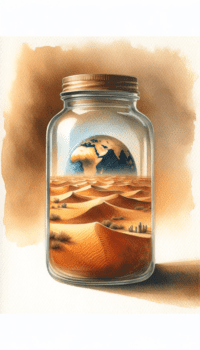
In this stirring portrayal, the third piece in the series “The Planet Earth in a Jar, Showing Only Deserts to Represent Climate Change,” we are presented with a scene that is both strikingly beautiful and subtly disquieting. The artwork renders Earth in a glass jar, not as the blue orb teeming with life as we know it, but rather as a planet overwhelmed by the sprawling sands and arid expanses of its deserts.
The desert within the jar is a mesmerizing landscape of rolling dunes, each wave of sand a testament to the dynamic yet life-challenging conditions of arid regions. Warm tones of amber, sienna, and russet bring to life the heat that radiates from these dry terrains, the color palette expertly capturing the myriad shades that paint real-world deserts at the golden hour. Small clusters of resilient vegetation, like cacti and hardy shrubs, dot the landscape, offering a glimpse into the stubborn persistence of life in conditions that are unforgiving.
The Earth, cradled by the curved glass of the jar, appears almost as a mirage within the desert, a precious oasis floating amid a sea of sand. This visual metaphor speaks volumes of the delicate balance of our planet’s ecosystems and the threat posed by the advancing deserts—a consequence of the relentless march of climate change.
The jar, with its lustrous metal lid, casts a pronounced shadow upon the surface it rests, symbolizing the weight of the issue at hand. The shadow falls to the side, suggesting the passage of time and the urgency with which we must address the encroaching desertification that threatens diverse habitats and human settlements alike.
This piece is not merely an artistic expression but a poignant commentary on the current state of our environment. It implores the viewer to consider the profound impact of climate change and the transformative effects it has on our landscapes. The jar, a vessel that both contains and protects its contents, becomes an allegory for our attempts to grasp and mitigate the environmental shifts that we are only beginning to understand.
Engaging and evocative, the artwork is a visual plea for awareness and action, asking us to look beyond the surface beauty to recognize the underlying challenges we face in preserving the balance of our delicate and beautiful Earth.
The planet Earth in a jar, showing only deserts to represent climate change, Artwork 4
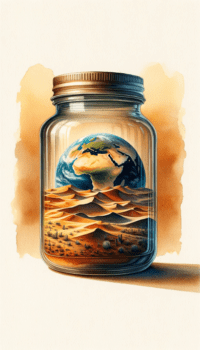
Titled “Desert Globe: A Climate Change Tableau,” this fourth artwork in the series “The Planet Earth in a Jar, Showing Only Deserts to Represent Climate Change,” delivers a potent visual message about the fragility and resilience of our planet. The artwork is a sublime fusion of realism and symbolism, where the artistry of the painter elevates an environmental commentary into a work of profound beauty.
At the forefront, the Earth appears almost as a precious gem within the transparent confines of the jar. Its continents, partially obscured by the sprawling deserts, are awash in natural colors, a reminder of the planet’s once diverse climates now increasingly encroached upon by arid sands. The deserts are rendered in sweeping strokes of sienna, ochre, and umber, their dunes rippling across the canvas like waves in a vast, sandy ocean. Here, the desert is not just a landscape; it is a symbol of Earth’s drying heartbeat under the strain of climate change.
The glass jar magnifies the deserts within, a visual metaphor for the magnified impact these environments have on global ecosystems and human livelihoods. The jar’s sleek curvature distorts and amplifies the view, suggesting that our perception of climate issues can be both contained and skewed by the lenses through which we choose to see the world.
Contrasted against a backdrop of earthy tones that echo the desert’s hues, the composition is at once harmonious and dissonant—the beauty of the artwork juxtaposes the sobering reality of environmental degradation. The Earth’s rounded form, cradled by the jar’s rigid structure, speaks to the interplay of natural organic shapes and the human-made geometries that often seek to dominate them.
The shadow cast by the jar is soft but undeniable, a gentle yet persistent reminder of the looming challenges cast by climate change. It stretches across the paper, an allegorical nod to the long-reaching consequences of desertification and environmental neglect.
Through delicate watercolor gradients and sharp contrasts, this piece invites the audience to reflect on the enduring impact of our ecological footprint. It’s a call to action, painted not with words, but with the poignant language of art, to recognize, respond to, and ultimately reshape our narrative with the Earth to one of balance and sustainable coexistence.
Summary:
Across four distinct yet interconnected artworks, the theme “The Planet Earth in a Jar, Showing Only Deserts to Represent Climate Change” emerges. From the gentle dunes to the harsh, sun-beaten sands, each piece encapsulates the diversity and the severity of desert landscapes. The Earth, vivid and vulnerable, is contrasted against the endless sands that threaten to engulf it, a powerful allegory for the pressing issue of desertification. The watercolor medium, with its fluidity and depth, perfectly captures the essence of our changing environment.
Conclusion:
Art has the profound ability to encapsulate complex global issues and evoke a visceral response. The “Earth in a Jar” series does just that, melding aesthetics with advocacy, and inviting introspection on our environmental impact. As we stand at the precipice of irreversible change, these artworks serve as a stark reminder: we are the custodians of this Earth, and it is within our power to forge a different path—one of harmony, sustainability, and hope. Let this series be the catalyst for conversation and change, as we work to reconnect with our planet before it’s reshaped beyond recognition.
Support the Project:
The “Life in a Jar: An Artistic Examination of Social Isolation” project transcends the boundaries of art, inviting us into a deeper conversation about our planet and our place within it. We can all play a part in sustaining this profound narrative. Here are ways to support the project:
- Financial Contributions: Consider making a financial contribution to the project. Your donations will fuel the continuation of this creative exploration and help bring more themes to life. Every donation, big or small, makes a difference and allows the artists to delve deeper into this critical discourse.
- Artwork Acquisition: Each painting in the “Earth in a Jar” series is more than an image; it’s a story, a dialogue, a piece of a larger puzzle. By purchasing an individual artwork or a complete set, you not only become a custodian of this tale but also support the artists and their vision directly. These pieces are not just decor; they are conversations starters, heirlooms, and legacies.
- Join the Dialogue: After reading about the “Earth in a Jar” artworks, start a discussion with friends, family, or online communities. Share your thoughts, feelings, and insights. The conversation that begins in contemplation can lead to action and awareness, which are pivotal in addressing the themes of isolation and environmental responsibility.
- Spread the Word: If the “Life in a Jar” project resonates with you, become an advocate for its vision. Share articles, posts, and images on social media. Invite others to join the project community, to experience the art, and to become part of the growing conversation. The more we talk about these issues, the more we can do to address them.
- Host an Exhibition: If you have the means or connections, consider hosting an exhibition of the “Earth in a Jar” series in your local community center, gallery, or school. Physical exhibitions can bring people together and create a space for dialogue and connection. Please contact us to get started.
- Volunteer Your Skills: Are you a writer, a social media influencer, or an event organizer? Lend your skills to the project. By offering your expertise, you can help amplify the project’s message and reach a wider audience.
In whatever way you choose to support, you become part of a collective effort to not only appreciate the profound beauty of our world but to also preserve it. Together, through art and dialogue, we can inspire change and foster a more connected and conscious global community.

